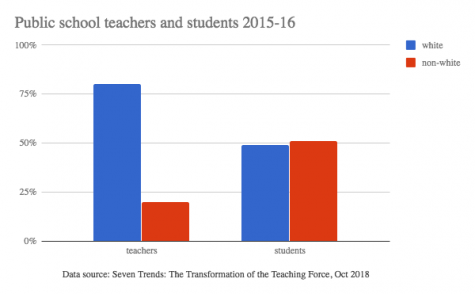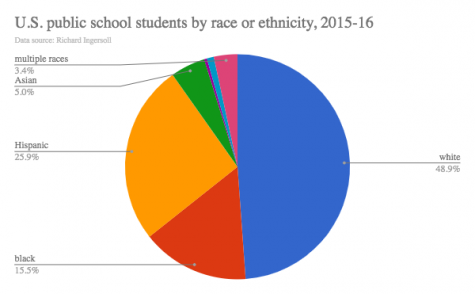Non-white teachers have increased 162 percent over the past 30 years, but they are also more likely to quit
New data paints a picture of an increasingly unstable teaching force of rookies
Jackie Mader/The Hechinger Report
Hispanic teachers numbered more than 335,000 and the number of non-white teachers surpassed 760,000 in the 2015-16 school year.
November 19, 2018
There’s been a lot of hand-wringing over the fact that the U.S. teaching force is mostly white but the students in our classrooms are now mostly black, Hispanic and Asian. Although the latest federal data shows a dramatic surge in the number of black and Hispanic teacher hires, these same teachers continue to be among the most likely to leave the profession, with many churned out soon after they are hired and before they have a chance to develop strong teaching skills.
“No, we don’t have parity,” said Richard Ingersoll, a professor at the University of Pennsylvania, who has been documenting changes in the teaching labor force. “But there’s actually been a massive increase in the numbers and percentages of minority teachers in this country over the last three decades. It’s actually sort of an unheralded victory. It’s all the more remarkable because minority teachers have higher quit rates.”
Ingersoll and his colleagues at the Consortium for Policy Research in Education analyzed teacher and school principal surveys, administered every four or so years by the federal government, to paint a picture of the teaching force and highlight trends. Their first 2012 report tracked changes from 1987 through 2008. He and his colleagues have since updated these findings twice, in 2014 and now in 2018, with data through the 2015-2016, which recently became available.

This 2015-16 data shows that 20 percent of the 3.8 million public school teachers in the U.S. were non-white, compared to 51 percent of students. That’s up from 17 percent non-white teachers and 44 percent non-white students in 2011-12, the school year in the previous report.
This seemingly small three percentage point increase represents a dramatic jump of roughly 150,000 more non-white teachers in the profession, from over 610,000 in 2011-12 to more than 760,000 in 2015-16. And it’s a staggering 162 percent increase in the number of non-white teachers since 1987, when there were only 290,000. For comparison, the number of non-white students increased by 96 percent during these same 30 years. From this perspective, the improving diversity of the teaching force is outpacing the rapid demographic changes that are sweeping through the nation’s classrooms.
The largest racial or ethnic group among the roughly 760,00 non-white teachers are Hispanics with more than 335,000 teachers, followed by blacks with more than 250,000 teachers. Asian teachers numbered fewer than 90,000, accounting for fewer than 2 percent of all public school teachers even though Asian students made up 5 percent of the student population. The gap for Hispanics is greater, however, with Hispanics making up more than a quarter of the student population but accounting for fewer than 9 percent of teachers. The black student-teacher gap is similar to the Asian one with blacks accounting for 15 percent of students but 7 percent of teachers.
The increase in non-white teacher hiring is accompanied by a high rate of departures. Ingersoll has not yet calculated the turnover rates for the new 2015-16 data, but when he last conducted this analysis for 2012, non-white teacher turnover was 25 percent higher than for whites. Specifically, 19 percent of black, Hispanic, Asian and other non-white teachers left the profession in 2012, compared with 15 percent of white teachers.


Part of the reason for the higher turnover rate is a side effect of the effort to recruit more non-white teachers. The highest quitting rates have always been among beginning teachers in their first few years as they decide whether they enjoy teaching and can cope with the emotional stresses of working with children. Forty-four percent of new teachers leave within five years.
Quit rates also run high in low-income schools where the working conditions are more difficult and student needs are greater. Non-white teachers are more likely to take jobs in poor schools and that leads to higher turnover. It is unclear from this analysis if non-white teachers have higher quit rates than white teachers once you control for years of teaching experience and school poverty.
Separate from this numerical analysis of the teaching force, Ingersoll has studied why non-white teachers quit. In surveys, non-white teachers who leave the profession frequently reported frustration with how their schools were run, with the extreme focus on test scores and with the inability to teach the way that they wanted to. One possibility is that principals in high poverty schools, who are coping with how to manage so many rookie teachers, might give their teachers less autonomy.
In many ways, the experience of non-white teachers sheds light on issues with the entire U.S. teaching labor force. Over the past 30 years, the number of teachers has expanded by three times the amount that the student population has increased, as new teachers have been hired to reduce class sizes and fill new specialist roles, from elementary school science to English language for non-native speakers. Meanwhile, veteran teachers of the baby boom era are retiring. Indeed, the latest 2015-16 data shows that the peak of those retirements has now passed. That leaves American students to learn from younger, less experienced teachers — black, brown or white. Back in 1988, the most common teacher was a veteran with 15 years of classroom experience. The most common teacher now is one with one to three years in the classroom.
“There’s been a huge increase in the proportion of the occupation that are new teachers,” said Ingersoll. “It’s a cost savings in terms of salaries. But it could hurt student achievement. We have solid research that you get better at teaching over time. In your sixth year, you’re better than in your first.”
Unfortunately, it looks like fewer teachers will make it to that sixth year.
This story about non-white teachers was written by Jill Barshay and produced by The Hechinger Report, a nonprofit, independent news organization focused on inequality and innovation in education. Sign up for the Hechinger newsletter.




















